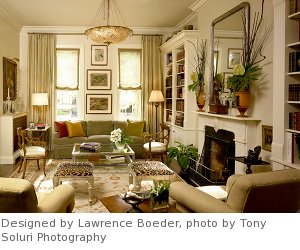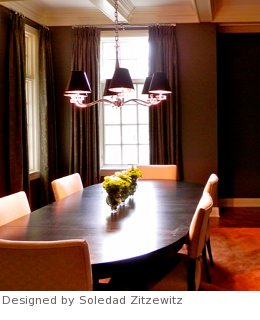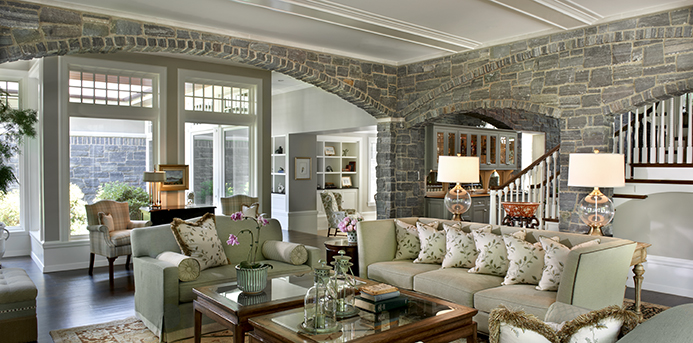Few things can enhance or detract from a beautifully designed interior more than window treatments.
We asked 3 top interior designers, each a participant in the Infant Welfare Society of Chicago’s 2011 Lake Forest Showhouse, for their thoughts and expert advice on window treatments.
Complement the Architecture
An expert in historic preservation, Frank Ponterio takes cues from a home’s architecture when designing window treatments for his clients. He creates grand gestures that also meld seamlessly into a home’s overall aesthetic.
When it makes design sense, he incorporates interesting and unexpected details with trimmings and tiebacks, and will often echo architectural details with the hardware.
As Soledad Zitzewitz reminds us, the temptation is go overboard and then your window treatments interfere with the surrounding architecture. “Your drapery should be part of the whole. Think of it as your hat. When it works, you can appreciate the entire ensemble. But chances are if you only notice the hat, you’ve gone too far.”
 Just as they should complement the interior architecture, for Larry Boeder well-designed window treatments should also frame the view outside, similar to how a work of art is enhanced by a frame.
Just as they should complement the interior architecture, for Larry Boeder well-designed window treatments should also frame the view outside, similar to how a work of art is enhanced by a frame.
And keep in mind that draperies can be seen from the outside of the home as well. Take a step outside to evaluate what you will see.
Create a Vignette
Consider your window treatment as part of a larger composition. For example, Zitzewitz often hangs art on either side of a window, visually connecting the valance to the room below.
Ponterio agrees and often elongates windows by extending drapery from floor to ceiling.
Remember that the style you choose can elevate the room to a more formal feel, or bring it down to a more casual vibe.
Layering as an Option
Privacy or shade is usually considered before aesthetics. Layering two window treatments together will serve both needs. Pair shades with drapes or valances to give you a working element and preserve the condition of your drapery—often the more significant investment. Ponterio also pairs window treatments to create depth within the window vignette by combining over-drapery fabrics with sheers, side panels with woven shades, or simply tying fabric back.
 Never Skimp on Quality
Never Skimp on Quality
Quality is essential not only in the craftsmanship of your window treatment, but in the fabrics you choose.
When choosing your fabric, Ponterio tells clients, “Don’t just look at your fabric on the coffee table. Feel it. Does it drape well or is it too stiff? Will it create the desired effect and hold its shape? Think about drapes like clothing. How will they wear? Will they wrinkle?”
Regardless of the fabric or style you choose, always fully line your window treatment, and for drapes Ponterio always recommends a two to one fullness (48 inches of fabric for a 24 inch span).
If your budget is limited, Zitzewitz suggests investing in quality fabric and opting for sumptuous and simple. Simple can be timeless and enduring, allowing you flexibility to play with other elements in the room. And if it’s a choice between using more fabric or adding more detail, go with more fabric. Nothing detracts more than a skimpy window treatment.
Lead photo: Designed by Frank Ponterio, photo by Barry Ruskin

